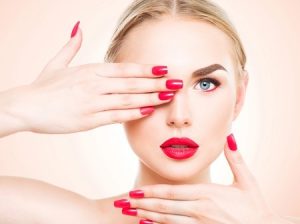
The waxes are added in various forms depending on their availability and use in the process. They can take the forms of either a powder, flake, prill pellett or solid form. Silicone compounds are also sometimes used in the base formula.
Lipstick ingredients also include emolients, pigment dispersants, preservatives, and fragrances. Some products also incorporate additional properties such as UV protection or pearlescent finish.
A typical ratio of oil: wax: pigment in lipstick is as follows:
- Oil 50 – 70%
- Wax 20 – 30%
- Pigment 5 – 15%
Lip Salves and balms are formulated from a similar base, but instead of pigments they contain additional moisturizers, sunscreen agents, or active ingredients such as camphor.
Lipsticks are generally manufactured in small batches. A typical manufacturing process would be as follows:
- The oil is heated in the process vessel to 175 – 185°F (80 – 85°C). The waxes are melted separately in a hemispherical jacketed vessel which is often called a “kettle” and typically fitted with an anchor stirrer/scraper. Part of the oil may be added to the kettle to aid the process.
- The wax phase is added to the oil phase. Various types of mixers/dispersers are used to combine the two phases.
- A “pigment grind” is prepared by dispersing the powdered pigment into part of the oil using a triple roll mill, bead mill or similar conventional mill. Increasingly premicronized pigments are used. These do not require grinding as such but some degree of shear may be required to break down any agglomerated particles.
- Ready-to-use liquid pigment dispersions are also widely used despite the increased cost. These can be added directly to the oils and waxes without pre-processing.
- The pigment grind is added to the oil/wax phase and mixed until a homogeneous product has been achieved. This may require passing through a colloid mill or similar.
- The mixture is cooled slightly before fragrances, preservatives, and other ingredients are added.
- The finished product is held at a lower temperature before being poured into moulds (molds) and cooled to solidify.
- The sticks can be “flamed” to produce a glossy finish to the surface.
The process is subject to a number of problems:
- Long process times are required to melt the waxes; solid pieces may require breaking up before they can be added to the kettle.
- Pigment grinds and pre-dispersions are difficult to disperse into the oil/wax medium due to the widely differing viscosity.
- The end product may require passing through a mill to obtain the required consistency and homogeneity.
Ref: Explained to me at the ‘Making Cosmetics Show 2016’, Ricoh Stadium on the Silverson Mixers stand.
I like this article very much. Making a lipstick is quite easy really. Lets hope we can try this.